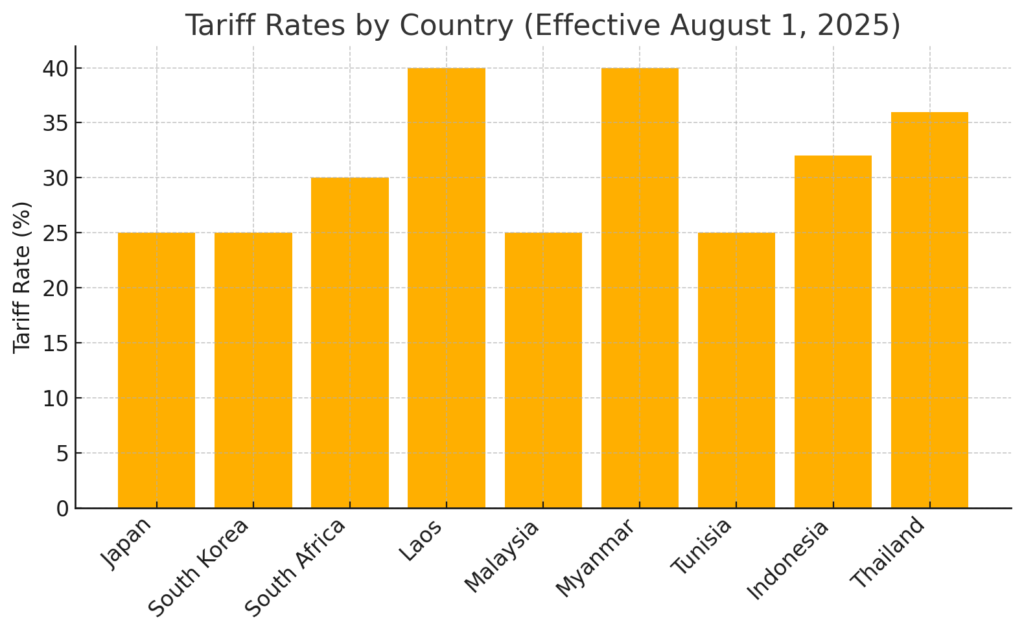
Main Points:
- New tariffs announced: From August 1, 2025, the Trump administration will apply a 25% tariff on imports from Japan (alongside similar measures on South Korea, Malaysia, etc.).
- Equity markets dip: U.S. stocks fell (S&P 500 –0.8%, Nasdaq –0.9%), reflecting renewed trade tensions.
- Crypto resilience: Bitcoin holds above $108,000 despite a 4% market-cap drop; analysts see only short-term headwinds.
- Technical outlook: Crypto derivatives, funding rates, and support/resistance levels hint at a potential rally toward $120,000 in Q3 2025.
- Political backdrop: Elon Musk’s new “America Party” and broader regulatory clarifications (“Crypto Week”) add fresh catalysts for digital-asset adoption.
- Practical takeaways: For yield-hungry investors, current on-chain metrics and derivative signals point to strategic entry opportunities before a projected late-2025 bull run.
1. Tariff Announcement and Geopolitical Context
On July 8, 2025, the White House trade office notified more than 10 countries—including Japan and South Korea—that, effective August 1, they will face punitive tariffs. Japan will see a 25% levy on eligible imports (mirror-measures also apply to Malaysia at 25%, South Africa at 30%, Indonesia at 32%, etc.). This measure follows a 90-day suspension—during which rates were temporarily cut to 10%—and signals the end of that reprieve. The administration left open the door for negotiations but warned that any retaliatory actions would trigger further tariff hikes.
Effective tariff rates by country:
- Japan: 25%
- South Korea: 25%
- South Africa: 30%
- Laos: 40%
- Malaysia: 25%
- Myanmar: 40%
- Tunisia: 25%
- Indonesia: 32%
- Thailand: 36%
(See chart above for a visual breakdown.)
2. U.S. Markets React: Equities Take a Hit
The tariff news rattled U.S. equities. The S&P 500 slid 0.8% and the Nasdaq Composite dropped 0.9% on the day. Investors fear that renewed trade barriers could slow corporate earnings and throttle cross-border commerce.
3. Crypto Market Response: A Short-Term Pullback
Despite equity volatility, the cryptocurrency sector remained buoyant. Over the past 24 hours, total crypto capitalization fell 4%, yet Bitcoin held firm above $108,000 (trading around $108,016.38 at mid-day) with a market cap near $2.14 trillion. This stability suggests that digital assets are decoupling from traditional risk markets in the face of geopolitical stress.
4. Technical Outlook: Is $120,000 Next?
Analysts point to on-chain and derivatives data signaling a potential breakout:
- Resistance & support: Bitcoin’s immediate barrier sits at $110,000; failure to clear could trap prices between $107,000–$110,000 for weeks, but a decisive close above $110,500 may target $113,500–$115,000 next.
- Derivatives sentiment: Long positions and open interest in futures have flipped bullish, hinting at institutional re-entry for a push toward $120,000.
- Long-term cycle: The Bitcoin Rainbow chart forecasts a cycle peak between $157,000–$217,000 in Q4 2025, suggesting current dip could be a buying opportunity.
5. U.S. Political Dynamics: “Crypto Week” and the America Party
In tandem with tariffs, the U.S. administration declared a “Crypto Week” aimed at clarifying regulatory frameworks for digital assets. Meanwhile, Elon Musk—former head of the “Administrative Efficiency Bureau (DOGE)”—has launched a new “America Party,” decrying excessive federal spending and pledging support for Bitcoin as a hedge against fiat devaluation. Musk’s move injects fresh political attention on crypto, potentially accelerating adoption if his party secures even a handful of congressional seats.
6. Practical Implications for Crypto Investors
- Short-term strategy: Consider scaling into positions as Bitcoin tests $107,000 support—tighten stops just below $105,000.
- Derivative plays: Monitor futures open interest spikes; elevated funding rates could tip a swift rally.
- Diversify: Look at correlated altcoins (e.g., Ether, Solana) which may follow Bitcoin’s lead in a broader “risk-on” rebound.
- On-chain signals: Track net network growth and realized cap metrics; past tariff shocks saw network adoption accelerate as investors sought decentralized value stores.
7. Visualizing the Tariff Shock and Crypto Resilience

(Tariff chart displayed above.)
Conclusion
The upcoming 25% tariffs on Japan and peers represent a clear escalation in trade friction. While U.S. equities have recoiled, the cryptocurrency market’s relative stability—and bullish technical indicators—highlight digital assets’ growing appeal as an alternative hedge. Coupled with evolving U.S. regulatory clarity (“Crypto Week”) and high-profile political endorsements, the current pullback may offer a tactical entry before a broader Q4 2025 rally. For yield-hungry investors and blockchain practitioners, now is a critical window to explore new crypto projects, refine on-chain strategies, and position for what could be the next defining bull run.

